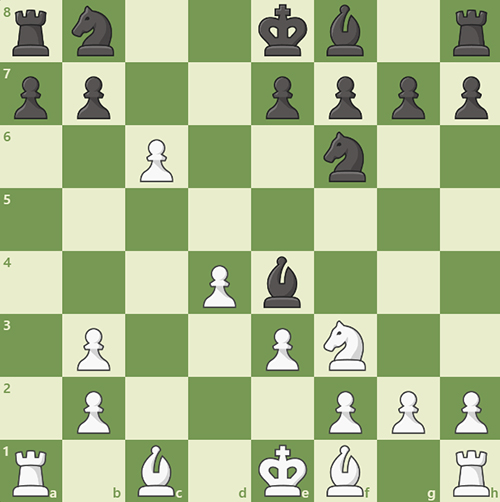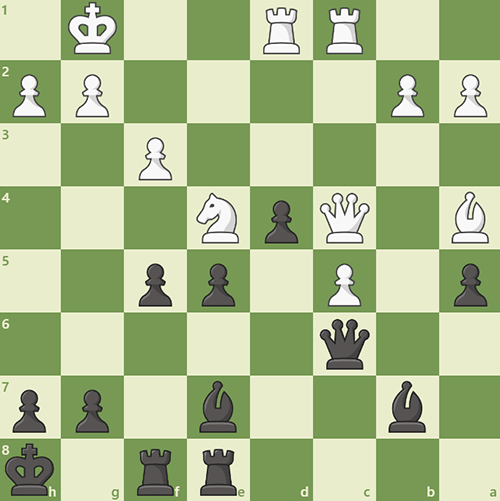
In chess, a passed pawn is a pawn without any opposing pawns in front of it to prevent its progression toward the eighth rank, a particularly powerful weapon as only the enemy pieces can avert its advancement. This concept is demonstrated in Figure 1, a position analyzed by Carl Schlechter and Julius Perlis in 1911. White is down a knight for two pawns but has a pawn on c6, only two squares away from promotion. However, if white pushes the pawn immediately, black simply has knight to c6, and the a8 rook defends the c8 promotion square. Therefore, the winning move is the rook takes a7, sacrificing the rook and forcing black to the back on a7 to avoid losing their rook. Having successfully drawn the a8 rook off of the backrank, white can push the pawn to c7 and black is rendered helpless to prevent the promotion of the passed pawn. If knight to c6, black can make a queen on c8 and if king to d7, black can capture the knight on b8 while promoting to a queen.
Figure 2 is a position from an exhibition game played in 1911 between the brilliant early chess masters Alexander McDonnell with white and Louis Charles Mahe de la Bourdonnais with black from a casual match of theirs in 1834, London. Material is equal but the white knight is hanging on e4 and white’s a4 bishop is skewering the black queen on c6, forcing 1… Qh6 2. Bxe8, losing the exchange but activating the black queen along white weak dark squares. However, tactics begin flying immediately as black refrains from capturing the bishop and instead continues with 2… fxe4, preparing to advance the pawns further along the board and apply pressure to white’s kingside while still attacking the bishop on e8. McDonnell counterattacked with 3. c6, hitting the bishop on b7, but La Bourdonnais, leaving his bishop hanging and refraining from capturing on e8, accurately continued to march down the board with 3. exf3 to further advance his pawns and open the white kingside. 4. Rc2 Bc8 5. Bd7 f2 6. Rf1 d3 7. Rc3 and black’s three passed pawns continue to descend down the board with tempo, forcing white to respond defensively. 7… Bxd7 8. cxd7 e4 9. Qc8, sacrificing the queen to promote to a new queen if captured by the rook, as well as threatening Qxf8 to remove the bishop from e7 and promote to a queen on d8. 9… Bd8 10. Qc4 Qe1 11. Rcc1 d2 and black’s passers cascade down to the first rank while attacking white’s rook. 12. Qc5, threatening checkmate on f8, but La Bourdonnais simply has 12… Rg8 and white is helpless to the incoming onslaught. 13. Rd1 e3 14. Qc3 and the game ends beautifully with the sacrifice 14… Qxd1 15. Rxd1 e2 and McDonnell resigned as black’s triple connected passed pawns on the second rank threaten to promote in a multitude of ways with forced checkmate to follow shortly.

Figure 3 is from a game between International Master Mark van der Werf with the white pieces and Grandmaster Friso Nijboer with black from the 2001 Dutch Championship. Black is up a queen and a pawn for a rook and a knight, generally an advantageous difference; however, white is threatening to promote his passed pawn to a queen on d8. Therefore, the winning move for black is first rook takes d7, sacrificing the rook for white’s passed d pawn to prevent promotion. After capturing back on d7, white is up two rooks and a knight for a queen but black is able to win the game by making a passed pawn of his own by taking on f3 with the g4 pawn. This allows white to pin the black queen to the king with rook to g1 but after the brilliant sacrifice queen takes g1 followed by knight takes g1, black has pawn to f2 and white cannot prevent the promotion of the passer into a queen.

Figure 4 is a position from a game between Grandmasters Michal Krasenkow with white and Janis Klovans with black from the 1987 Soviet Army Championship. Krasenkow is up a pawn but it appears that Klovans has successfully blockaded white’s advances, and he almost has. That is, except for the fact that white is able to creatively advance his g pawn with the incredible sacrifice queen to h7 check, forcing the knight to capture. This allows the g6 pawn to recapture on h7 with a discovered check from the rook on g4 and white transforms the g pawn into a winning passed pawn on the h file. If the black king goes to h8, white has rook to g8 checkmate, and if the black king moves elsewhere, white can simply promote to a queen. If black blocks with rook to g6, white can capture with the rook, black is forced to block the check with the queen and white then has bishop takes g6. If the king captures, white can queen on h8, and if the black does not take the bishop, white is left with a straightforward, winning endgame up a bishop and a pawn.

Ethan Feder is a senior at Yeshivat Frisch, a chess enthusiast, instructor and player. The goal of his column is to teach and discuss chess concepts through example positions, high-level games and relevant puzzles, along with explanations. Feel free to contact him with any questions, suggestions or comments at ethan.feder@gmail.com.










